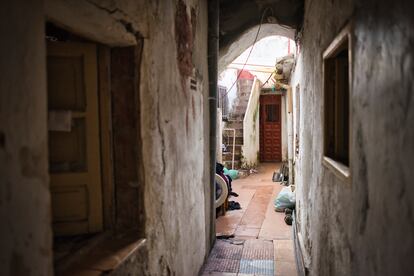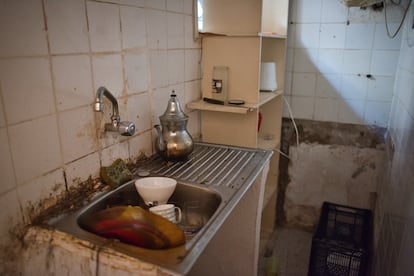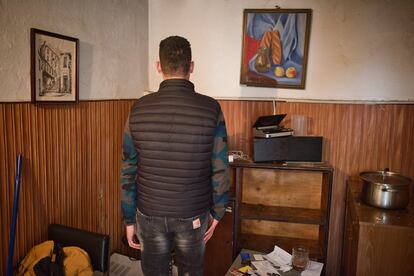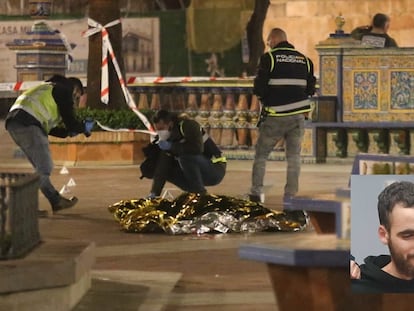Roommates of Spanish church assailant: ‘He said he saw the devil’
Residents of the squatter home in Algeciras where Yasine Kanjaa lived say he underwent a quick mental decline, but rule out any ties with Islamic terrorism


The dilapidated backyard of number 10, Ruiz Tagle street, in the southern Spanish city of Algeciras, is a mess. The chaotic scene is partly due to the police search that recently took place here, and partly because its occupant had been destroying everything in sight for weeks.
This individual is Yasine Kanjaa, a 25-year-old from Morocco who was arrested on Wednesday after going on a rampage with a machete, killing one church officer, seriously wounding another and causing injuries to several bystanders. Kanjaa is being held over the death of Diego Valencia, a sexton (an official who takes care of the sacristy and other areas of a Catholic church). He also inflicted serious wounds on a priest, Antonio Rodríguez, at another nearby church, after climbing on the altar and yelling that people should be following Islam. Authorities are investigating the case as a possible act of Islamic terrorism.
Mohammed (an assumed name) is one of seven people who had been sharing the squatter home with the suspect. He points at a light blue teddy bear lying on a staircase and says: “He claimed that was the devil.” Mohammed has spent a sleepless night testifying for the police, after his roommate went on a rampage at the Church of La Palma and at the nearby Church of San Isidro.
Mohamed points to Kanjaa’s few belongings. He is in the company of his cousin and another roommate, who all witnessed the suspect’s process of mental decline. But the 28-year-old Mohammed, who works a waiter in a bar in the port of Algeciras, is quite certain that Kanjaa had no ties to Islamist radicals: “He is a paranoid person, it is not jihadism. He threatened his own roommates with a knife. That kid is unwell, he used drugs, then he quit and started to pray.”

But Kanjaa was apparently not like that when he moved into the run-down first floor of the house with two other Moroccans, a few months after being served with an expulsion order from Spanish authorities, as is typically the case with the majority of undocumented migrants who arrive in Spain by sea. Originally from Oued El Marsa, a small town on the northern coast of Morocco, “he was a normal kid who dealt drugs and smoked joints. He earned some money and wore a tracksuit and [Nike Airmax 120] sneakers,″ explains Mohammed. Then, something changed about two months ago. Kanjaa stopped consuming drugs and started wearing a djellaba.
He began to talk about magic, witchcraft and demons, shouting “there is no god but Allah” in Arabic, but Mohammed does not remember seeing him read jihadist material, or even going to the city’s mosques, as two of these religious centers have confirmed. “Perhaps he dropped by a mosque, but we can confirm that he was not a familiar face,” explained Mohammed El Mkaddem, imam of the Al Huda temple and spokesman for the Islamic community in Campo de Gibraltar.
“He didn’t want some of us to drink alcohol, or for others to have a girlfriend without getting married first. It got worse, one of the kids got scared and left: two weeks ago he threatened to kill us all,” recalls his roommate.
On Wednesday afternoon, Kanjaa was even more agitated than usual. Mohammed was at work at the bar when, at around 6pm, he received a voicemail from his cousin, who had locked himself up on the top floor, frightened by what he was hearing below. “Something is going on, get here fast,” he urged in Arabic.
“He picked up a knife. His mates asked him what he was doing with it, and he told them, ‘I have this so that I can get rid of whoever wants to end my life,’” Mohamed says his roommates gave him this account when he got home from work. By then, the alleged murderer was already on the loose in the streets of Algeciras, on an erratic path that took him twice to the church of San Isidro (the second time is when he attacked the priest). He then assaulted a young Moroccan and, finally, inflicted the fatal injuries that killed the sexton, who he chased out of the church and to the Plaza Alta square.

Mohammed is feeling very bad about what happened. He arrived in Spain as an underage, undocumented migrant, and when he turned 18 he ended up on the streets, selling scrap metal and doing “whatever I had to do” to find a stable job. He has been living in the squatter house for over two years, on the first floor, and his wife and young daughter occasionally come to visit. “I get along well with the neighbors,” he says. A neighbor in the house next door agrees: “They don’t mess with anyone. It is a house where many young people come and go, it looks like they are just passing through. They stand in the doorway and do nothing, although sometimes they have helped me take my daughter’s stroller up the stairs. But I don’t pay much attention to them because it scares me.”
Now, Mohammed feels that Kanjaa has broken that peaceful coexistence with an attack he believes he could have prevented: “I wanted to report him to the police because I was afraid for my wife and daughter, but the rest of the squatters do not have legal papers, and they asked me not to call the police in case they were taken away. If I had, this wouldn’t have happened.”
The last time that Mohammed saw Yasine Kanjaa was before dawn on Thursday, when the police brought him back to the house so he could be present during the search. “I wanted to insult him, to yell at him: you are a murderer who lived here with me.” He did not, but he did make it clear that he was going to help with the investigation as much as he could. “I already told them, I am more concerned about what has happened than they are. Let’s see what will become of us now…”

Sign up for our weekly newsletter to get more English-language news coverage from EL PAÍS USA Edition
Tu suscripción se está usando en otro dispositivo
¿Quieres añadir otro usuario a tu suscripción?
Si continúas leyendo en este dispositivo, no se podrá leer en el otro.
FlechaTu suscripción se está usando en otro dispositivo y solo puedes acceder a EL PAÍS desde un dispositivo a la vez.
Si quieres compartir tu cuenta, cambia tu suscripción a la modalidad Premium, así podrás añadir otro usuario. Cada uno accederá con su propia cuenta de email, lo que os permitirá personalizar vuestra experiencia en EL PAÍS.
¿Tienes una suscripción de empresa? Accede aquí para contratar más cuentas.
En el caso de no saber quién está usando tu cuenta, te recomendamos cambiar tu contraseña aquí.
Si decides continuar compartiendo tu cuenta, este mensaje se mostrará en tu dispositivo y en el de la otra persona que está usando tu cuenta de forma indefinida, afectando a tu experiencia de lectura. Puedes consultar aquí los términos y condiciones de la suscripción digital.
More information
Archived In
Últimas noticias
Most viewed
- Sinaloa Cartel war is taking its toll on Los Chapitos
- Oona Chaplin: ‘I told James Cameron that I was living in a treehouse and starting a permaculture project with a friend’
- Reinhard Genzel, Nobel laureate in physics: ‘One-minute videos will never give you the truth’
- Why the price of coffee has skyrocketed: from Brazilian plantations to specialty coffee houses
- Silver prices are going crazy: This is what’s fueling the rally










































